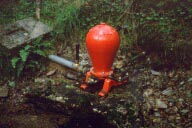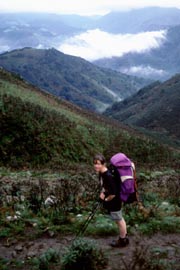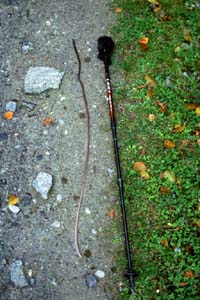In detail ...
The Basque country has a rainfall comparable to that of Ireland or the Lake District; how else could it be so green? As we rose above the mist on the flanks of Mandalé mountain, this hue calmed our minds, at least until the rain started; then we hurried on to reach Col d'Ibardin. The approach revealed the Swiss who could have stolen a march on us had they been up to break camp earlier. Ahead, the garish commercialisation at the col prompted an exclamation; 'Just when you thought you were in the country, up rears a shopping mall!' The Swiss joined us briefly and turned the occasion to advantage by escaping the rain for a coffee; sensible people.
The mall held little for us, we were keen to advance, progress, look over the horizon or around the next bend.
Karen_comments
So, our cags came out for a real test, and we set off on a march, tarmac initially before the confusion began. We had only just left the GR10, now to join what should have been a Spanish
pequeno recorrido, the PR13; it was marked on the map by a double red line, but was less well travelled than the single red line, which we pursued on tarmac. The unyielding surface alone made our diversion rather tedious, but much the worse for a great loss of height past a malodorous rubbish dump.
That 'sinking feeling' deepened as no way-marker materialised and the route curved northwards. I searched for a shortcut to make good the mistake but none was available and finally cracked; back we must go past the smelly tip. The noted woodland track was now obviously correct and it shortly led us to a small hunting
cabane, Ref Usatagieta which welcomes all during inclement weather. There we took advantage of water on tap and comforted ourselves with some breakfast; 'Fancy getting lost on only our second day out, huh!' We blamed the Spanish map.
A traverse contoured the north slopes of a wooded hill now, with outlook over the frontier into France. This set Karen off informing me details of the Spanish civil war and of the resistance fighters who might have travelled through these very woods. The traverse ended at a junction where the steepening track signalled proximity to La Rhune, our first challenge, but a very minor one compared with what the weeks ahead must bring. I was keen that we prove ourselves equal, but two things stood against me, in league; Karen and the weather. The peak was shrouded in cloud, and since a traverse was available, why bother mounting for a nul view? The cloud broke, then thickened; the argument won.
Karen_comments
We struck off on the PR16 and the wimp out did at least hold some interest; we collected early sweet chestnuts and scrumped apples to supplement our fayre, but would the reward counteract the extra stress incurred on loaded shoulders? Otherwise we were robbed of certainty for our decision as the cloud cleared over La Rhune within the half hour causing me to remark 'What a splendid view that must be from up there!' Even if it is in company of a restaurant, observatory and rail terminus; and a crowd of tourists. No, I was sorry we had missed climbing the rosy sandstone of this distinctive little peak.
The Octopus Stinkhorn
French: 'Clathre' champignon. This red 'star' fungus emerges from the earth as a soft gelatinous white 'egg' before bursting to separate and spread its five to eight arms. These develop a superficial olive-brown slime which smells of rotting meat.
Clathrus archeri is not unique to the Pyrenees or even France and is found in parks and beech woodlands. Originally native to the southern hemisphere, it appeared in France soon after a shipment of wool appeared in St Dié (Lorraine region), and has since spread and adapted throught-out europe, including the UK.
Our way passed by quiet homesteds with thriving
potagers to dip through a dank gully where we spotted the bizarre tentacles of the crimson 'squid' fungus. The route then ascended through a notable stand of natural plane trees; how unusual to see these tall flaky trunks leading to shapely branches unchecked by urban topping and lopping! Eyes focusing on the track gradually recieved first clues that worms here are
different for they had left casts of a size which no average earthworm could produce. Then the reality; a worm as big as a snake (75cm), cruising about on the path in broad daylight. Could this be one reason for the fertility of the Basque country?
We soon gained Col de Lizuniaga (230m) where our hopes of refreshment died. The tourist season here is well defined and short lived, July and August. Having no reason to linger we continued with the traverse of the squat peak Labeaga to arrive at Col de Lizarieta (441m) where we gained the well defined frontier ridge with shooting boxes every 50m. How any migrant bird survives when these are manned challenges comprehension, but the hides are in fact there for the pigeon hunters and gleaned statistics state that
only a third of the 4.5 million migrating pigeons are shot in passage.
Having walked on another 2km the day was late and we were tired and thirsty; we felt we had done more than enough, since we had already passed Col de Lizuniaga, Véron's named destination. So, we needed a campsite with water; not much to ask for except that we were on a ridge top. Karen's bid was to pitch right there on a broad grassy track; there, where still passed late walkers and the odd 4WD vehicle, she had had enough. So it was I who had to make that extra effort to find something a little more secluded; somewhere down the ridge front, I knew there would be a spring and a site, just for us.

The first gully I entered sourced only a mossy seepage, but after some crashing around through the bracken and shrubs I discovered another ravine with a captive water source, and curiously, a nifty little ram-pump newly painted with startling red paint. It sat quietly out of service, a bizarre splash of colour in the gloomy gully. Just up above it, I found us a pitch overhung by the spreading boughs of an ancient oak; so it was to this I retrieved Karen and our sacs at last. Here we lounged in the cooling day, our bellies filled with chestnuts. I didn't really wish to think we were tired at the end of just our first full days walking, but we turned in early and slept like logs.



